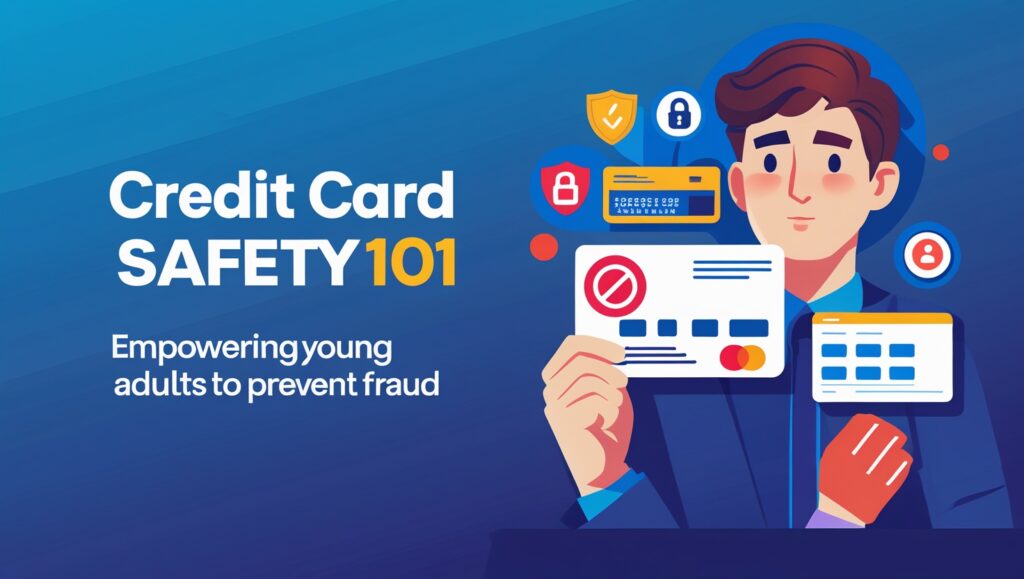Credit Card Safety
Tips for Young Adults to Prevent Fraud

Introduction
Credit cards provide young adults with financial flexibility and convenience, but they also come with risks, especially when it comes to fraud. In both the USA and Canada, credit card fraud is a growing concern, with scammers using increasingly sophisticated tactics to steal personal information and funds. Whether shopping online or using your card at a store, understanding how to protect yourself is essential. This guide will equip young adults with practical tips to prevent fraud and ensure secure financial transactions.
Understanding Credit Card Fraud
Credit card fraud occurs when someone gains unauthorized access to your card information and uses it to make transactions without your consent. Fraud can happen in various ways, including:
Phishing Scams: Fraudsters send fake emails or messages posing as your bank or a reputable company to trick you into providing personal information.
Card Skimming: Devices installed on ATMs or gas station card readers steal card details when you swipe.
Data Breaches: Hackers gain access to personal and financial information through company security breaches.
Stolen Cards: Lost or stolen cards can be used to make unauthorized purchases if not reported immediately.
Fake Websites: Fraudulent e-commerce sites trick consumers into entering card details, leading to theft.
1. Keep Your Credit Card Information Secure
One of the simplest ways to prevent fraud is to safeguard your credit card information. Follow these best practices:
Never share your card number, CVV code, or PIN with anyone.
Avoid saving card details on online shopping sites.
Store your physical card in a safe place and never leave it unattended in public.
Use a credit card rather than a debit card for online purchases, as credit cards offer better fraud protection.
2. Use Strong Passwords and Enable Two-Factor Authentication (2FA)
Many online accounts store your payment details, making them a target for hackers. Protect your accounts with:
Unique and complex passwords that include letters, numbers, and symbols.
Two-factor authentication (2FA) for added security, requiring a second form of verification, such as a text code.
A password manager to keep track of your login credentials securely.
3. Monitor Your Transactions Regularly
Frequent monitoring of your transactions can help detect fraudulent activity early. Here’s how:
Sign up for transaction alerts via text or email from your bank.
Check your credit card statements and online banking at least once a week.
Report any suspicious transactions immediately to your bank or credit card provider.
4. Be Cautious When Shopping Online
Online shopping is convenient but comes with risks. Protect yourself by:
Only purchase from reputable websites with “https” in the URL and a padlock icon in the address bar.
Avoiding deals that seem too good to be true, as they might be scams.
Using virtual card numbers or disposable cards for online purchases if your bank offers them.
5. Watch Out for Phishing Scams
Phishing is a common tactic used by scammers to steal financial information. Avoid falling victim by:
Never clicking on links in unsolicited emails or messages claiming to be from your bank.
Verifying the sender’s email address before responding to any financial request.
Calling your bank directly using the number on your credit card if you receive suspicious communication.
6. Use Secure Networks and Avoid Public Wi-Fi
Public Wi-Fi networks are not secure and can expose your credit card information to hackers. To stay safe:
Avoid making purchases or entering sensitive information while using public Wi-Fi.
Use a virtual private network (VPN) when accessing financial accounts from a public place.
Turn off automatic Wi-Fi connections on your phone or laptop to prevent connecting to unsecured networks.
7. Protect Your Physical Card from Skimmers
Credit card skimming remains a prevalent issue at ATMs and gas stations. Take these precautions:
Inspect card readers before inserting your card and avoid using suspicious-looking ATMs.
Use tap-to-pay or mobile payment options like Apple Pay or Google Pay to reduce card swipes.
Cover your PIN while entering it at ATMs or checkout terminals.
8. Set Spending Limits and Alerts
Many banks allow you to set spending limits and alerts on your credit card, which can help prevent unauthorized transactions. Consider:
Setting a daily spending limit to reduce the amount a fraudster could charge if your card is compromised.
Enabling instant transaction notifications to stay informed about your purchases.
Freezing or locking your card through your banking app if you suspect fraudulent activity.
9. Report Lost or Stolen Cards Immediately
If your card is lost or stolen, act fast to prevent unauthorized transactions.
Contact your bank immediately to report the loss and request a replacement.
Check your account for any unauthorized transactions and dispute them promptly.
Monitor your credit report for any unusual activity that might indicate identity theft.
10. Educate Yourself About Credit Card Fraud Trends
Fraud tactics are constantly evolving, so staying informed is crucial.
Follow financial security blogs, news, and your bank’s updates on fraud prevention.
Be aware of recent scams targeting young adults, such as fake job offers asking for financial details.
Attend online or in-person workshops on financial literacy to strengthen your knowledge.
Conclusion
Credit card safety is a vital skill for young adults in the USA and Canada. By following these fraud prevention tips, you can protect your finances and personal information from scammers. Always stay vigilant, monitor your transactions, and use secure practices when shopping online or using your card in public. Taking these steps will help ensure a safe and secure financial future.
